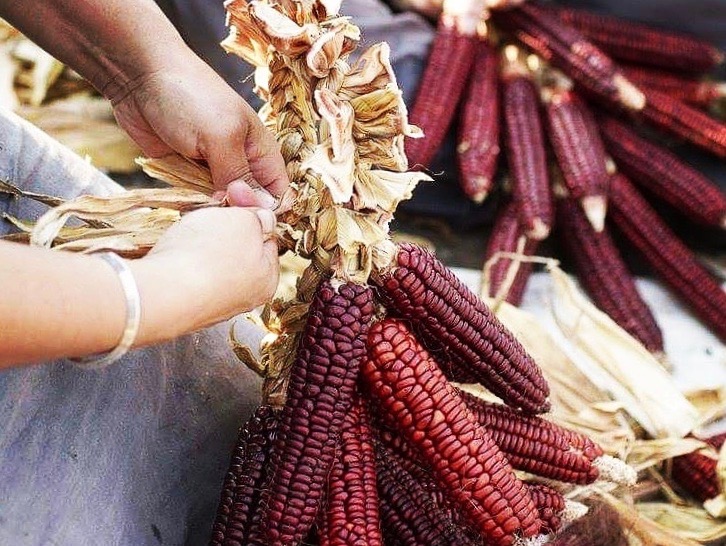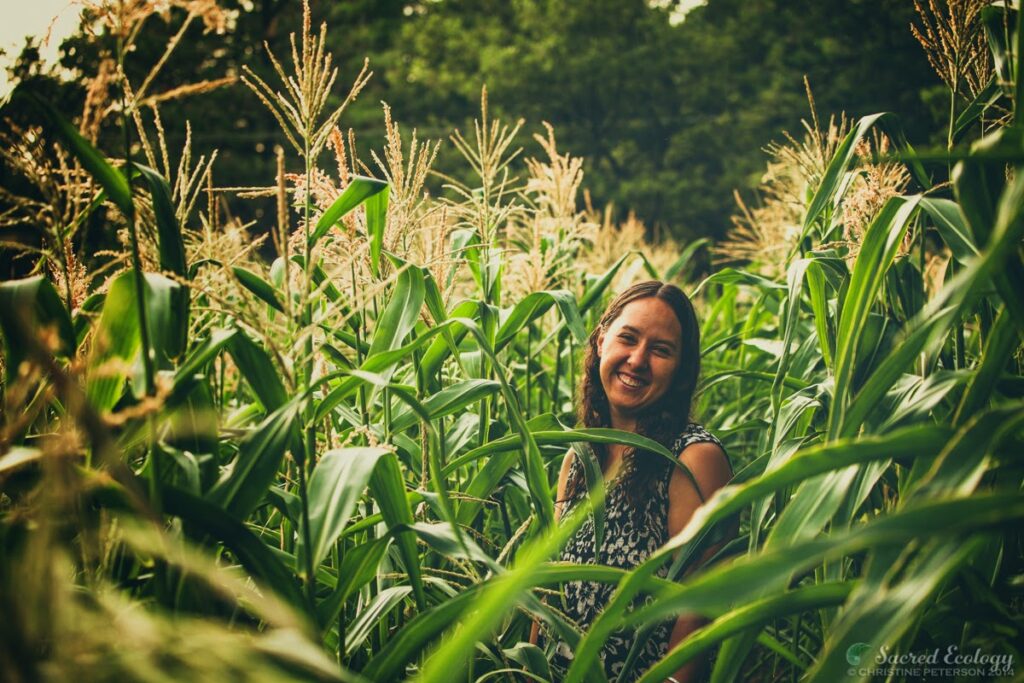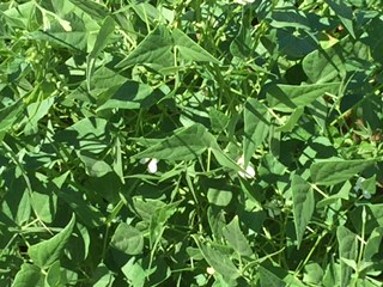As genetic engineering advances, Indigenous activists are working to protect ancient seeds from exploitation.
By Melanie Lenart

Even as Indigenous groups work to “rematriate” traditional seeds by bringing them home from museums and other collections, advances in western science over the past decade give geneticists the power to reconstruct ancient seeds and other living organisms from a computerized copy of their DNA sequence.
In the context of this Jurassic Park technology, what can Indigenous peoples do to protect the traditional knowledge contained in seeds developed by their farmers over countless generations?
That’s the question of the decade—made more pressing by the United Nations’ push to encourage the international collection of DNA sequences for as many species and varieties as possible by 2030 as part of its Global Diversity Framework.
Nationally, the question is also pressing in the context of the Dec. 1 federal memo providing Guidance for Federal Departments and Agencies on Indigenous Knowledge. The agency efforts include providing grant support for tribal nations willing to share some of their knowledge.
The first article in the three-part series about the federal guidance discussed some of the benefits resulting from the government’s push, focusing on efforts to co-manage public lands with tribal nations. The second article raised some legal issues affecting the protection of Indigenous knowledge in the context of existing laws.
This last article in the series explores the collision of the Indigenous and western worldviews around genetic resources in the context of recent technological advances. It will cover the extent of those advances, national and international efforts to capitalize on them, and efforts to protect Indigenous seeds by activists and scholars.
Code-breakers for Indigenous knowledge
Protecting seeds from exploitation is no easy task. Much of the Indigenous knowledge used in their development rests in their internal genetic code—and that code has become easy to crack with recent technological advancements.
“Traditional knowledge was used to create those sequences. It’s embodied in the sequences, so to say,” explained Preston Hardison, a retired policy analyst for the Tulalip Tribes of Washington who continues to work on data sovereignty issues with the World Intellectual Property Organization.
Hardison said he wouldn’t expect the federal government or any nation to force Indigenous peoples to contribute to seed banks. However, he said the recent technological advances create an avenue for the potential theft of the Indigenous knowledge inherent in traditional seeds.
“Once you have the sequence, you no longer need access to the DNA,” Hardison said. “To some extent, there are ways now—think of it like 3D printing—you can reverse the process. You can use techniques to turn the information back into physical things.”
For conceptual purposes, we can think of the genetic code as the organic version of computer code. Instead of the 0s and 1s that comprise computer code, genetic code is composed of compounds that provide a similar binary effect: C and G work together for one DNA signal (think 0), while A and T combine to signal another message (think 1). Although it’s somewhat more complex than the binary code of computers, it’s the sequence of these two combinations—known to geneticists as “digital sequencing information”—that creates the mind-blowing variety of life forms.
The development of this genetic technology has, by all accounts, been phenomenally fast. A 2012 publication in Science heralded the creation of a gene “editing” tool known as CRISPR, developed by two scientists who found a way to use source material from bacteria to zoom in on specific sections of the genetic code and delete or alter it. Proponents call this an “edit,” presumably to avoid calling them Genetically Modified Organisms, or GMOs. The scientists, both women, went on to win the Nobel prize in 2020 for their innovation.
The discovery spurred a frenzy of activity among geneticists. Within six months, another scientist recognized the same tool could apply to mammals. This includes humans. Within a decade, a collaboration between the United States, Europe and Japan to store the digital data contained more than 228 million sequences of genetic code.
Now, open access to the database—free of cost and restrictions, and for use by multinational corporations as well as scientists—has become a non-negotiable demand for some of the international participants working to fulfill the United Nations’ goals for the Global Biodiversity Framework by 2030. At the same time, some proponents are seeking to expand their access to the seeds and other genetic resources held by Indigenous peoples.
An international clash of worldviews
Rowen White, who advocates for what she calls the “rematriation” of Indigenous seeds from museums and seed banks back to interested tribal nations, perceives a “big collision” between the proponents of collecting genetic sequences and Indigenous worldviews. White founded the business Sierra Seeds, which among other things offers an online course to interested seedkeepers and also develops programs for the Indigenous Seedkeepers Network.
“Even if they say ‘Well, it’s free, nobody is commodifying this, there’s a lot of room for economic exploitation of some of these genetic sequencing and coding projects,” she said. “All of that is backed by big multinational corporate dollars that are not just doing this as charity, right? No, there are definitely dollars behind all of that research and those technologies that want to patent those gene sequences and all that stuff for corporate profit.”
The rush to move forward on genetic sequencing, which international scientists call DSI for Digital Sequencing Information, also has created some resistance among less wealthy member countries of the United Nations.
“Biodiverse nations, many of which are low- and middle- income countries, believe their sovereign rights have been undermined because any potential monetary gains from DSI commercialization are not shared back with them, as they would be with a genetic resource,” wrote the authors of a 2022 Nature article.
The article was written by 41 scientists eager to develop a policy framework on how benefit sharing could work for the digital sequencing information. It mentions nothing about Indigenous peoples beyond noting many “unanswered questions” remain. They hint that perhaps Indigenous peoples could somehow receive funding from profits earned with the use of genetic sequencing data from plants or seeds from their lands, but also make it clear that they believe the database must remain free of cost, and free of complex regulations.
A 2023 Nature paper encourages researchers to see Indigenous peoples and local communities as partners in genetic sequencing projects. Still, the journal article considers only issues related to inclusion in research design and benefit-sharing ideas rather than acknowledging an outright disagreement with the approach.
Yet White, a member of the Kanien’kehá:ka tribe affiliated with the Haudenosaunee (also known as a Mohawk member of the Iroquois Confederacy), made it clear that she found the approach problematic well beyond monetary issues.
“I think what we’re dealing with is a clash of cosmovisions and worldviews in terms of how we are in relation to seeds,” she said. “The end goal for some of these gene banks, the places where they’re storing these, is to create a more productive and efficient industrial agricultural seed, and that has a different value set. They value uniformity, they value yield and productivity, they value profits.”

Piecemeal v. holistic
Indigenous peoples, White said, look at it more holistically.
“What Indigenous peoples are bringing in is the layers of cultural and spiritual memory that are encoded inside of that seed as a holistic sovereign being. And that’s where I feel like the western science perspective of thinking that cutting and splicing and cataloguing and creating libraries of these genetic sequences as a means to be resilient into the future fall short.”
White pointed out that much of remaining biodiversity on the planet exists in “hotspots” of land managed by Indigenous peoples. Biological diversity works at the landscape level, with values going up with the number of species or even ecosystems on the landscape. Genetic diversity within a species also can be important for its long-term survival—and for its ability to adapt to climate change. All of these forms of diversity tend to be higher on Indigenous lands.
“Ultimately we are working in reciprocity with those plants to find something mutually beneficial, as opposed to the sort of western science or the industrial viewpoint of being in a more extractive, exploitative role with these plants or seeds that is designed to only serve us and might not necessarily serve the plants at large.”
One of the ways Indigenous peoples retain biodiversity, she said, is by allowing plants to express a variety of traits, and not trying to make fruits and vegetables so uniform.
Genetically modified organisms can take uniformity to an extreme. Not only might one crop be grown in large fields, but those plants might even be genetically identical clones. What’s more, the decline of pollinators that’s threatening to crash insect biodiversity is linked, in part, to the removal of other flowering plants from in and around the monocultural fields that dominate in western agriculture.
Protection for seeds under US law
Michael Kotutwa Johnson, a Hopi farmer and University of Arizona researcher specializing in Indigenous resiliency, raised similar concerns about the lack of biodiversity under western approaches and multinational corporations profiting from the Indigenous knowledge inherent in seeds.
“Since the adoption of federal guidelines to traditional ecological knowledge, it’s going to make it very difficult for Indigenous knowledge not to become the new mining industry out there,“ Johnson said. At the same time, he recognizes many benefits of the guidance, as described in a previous article.
The federal guidelines highlighted a project known as Buena Milpa. The project description lends support to concerns about uniformity in western agriculture as well as the potential for bioscience companies to take advantage of Indigenous seeds for their own purposes.
The only reference to “seeds” in the 46-page Guidance document and Appendix provided by the Biden administration involves the USAID Buena Milpa project, described as involving “mostly Indigenous Mayan farmers in the highlands of Guatemala.” Farmers participated in a research study that found their traditional forms of agriculture—involving intermingling of the corn, beans and squash plants—resulted in more overall nutrition in the food than those grown in western fields of single crops.
Along the lines of the Buena Milpa project, Johnson is setting up an experiment to compare the nutrition from plants grown the Hopi way from his family’s heritage seeds to plants grown in treated soil with the industrial method, using synthetic chemical compounds such as fertilizer and pesticides.
“If we can prove the nutritional and cultural value of these crops, then we have that much more leverage to get funding to upscale this traditional agriculture in the communities that they came from,” he said. “We want to make sure these communities also have the research and data storage facilities to empower the youth to go into the sciences.”
Seed exchange embedded in project
Alongside the nutritional research, the Buena Milpa project encouraged farmers to trade varieties of staple food, such as maize, yams and beans. Meanwhile, the federal guidance document also noted that the International Maize and Wheat Improvement Center’s participated in the project—meaning the seeds, known as “germplasm” to western scientists, could serve as “source material” for bioscience firms.
“In some cases, germplasm (seeds) developed by smallholder farmers has been the source material for important crop-saving and agronomic improvement technologies deployed by bioscience firms and redistributed to farmers worldwide,” the guidance memo states in Appendix A on page 26. “Such collaborative innovations highlight the need to track the provenance of seeds and genetic resources and to respect and reward the intellectual and creative contributions of Indigenous and local peoples on par with that of Western bioscience.”
Highlighting the need is not the same as actually doing something about it, though. Meanwhile, laws on the books allow universities to earn money by commercially patenting inventions and discoveries by their employees, Hardison noted. The Bayh/Dole Act, passed in the 1980s with bioscience in mind, allows public universities to do so even if federal funding was involved.
“That’s their bread and butter,” Hardison said. “That’s how they (universities) raise money now, is through commercialized products.”
As a case in point, the development of the “gene editing” CRISPR tool described above has led to a legal battle over the patenting rights between the three academic institutions that employed the scientists involved in its discovery, and its modification for mammals.
Ask the question: Who profits?
Although Johnson doesn’t support genetically modifying seeds and crops, he was adamant that Indigenous communities should benefit if any of their genetic resources, derived from their beans, corn, squash and other domesticated crops, contribute to a money-making patents.
“Those communities that have raised these seeds (should be) the beneficiary of what we do at the university,” he said.
The Hopi, Gila River and Tohono O’odham tribes, for instance, have spent countless generations cultivating tepary beans, touted as the most drought-resistant bean in the world. In the context of a warming climate, commercial cultivators would like emulate their success—but most would prefer using the shortcut of identifying the tepary bean’s drought-resistant genes so they can recreate them at will. Under the current international set-up, a company could identify those genes and even patent that trait, but no tribe would profit from their millennia of breeding that brought the bean so far.

Johnson said he won’t proceed with his research plan unless his home institution, the University of Arizona, commits to protecting his family seeds from potential exploitation.
As he noted, Article 31 of the United Nations Declaration on the Rights of Indigenous Peoples lists seeds among the traditional knowledge and its manifestations that Indigenous peoples have the right to protect. Although the United States has adopted the declaration as “aspirational” rather than regulatory, Johnson said it still could offer some value.
“That’s important because right now we don’t have anything in the United States that would support or help or protect Indigenous-based seeds,” he said.
The university also has encouraged him to set up a supplementary Internal Review Board for any projects involving Indigenous agriculture and seeds to help ward off conflict and future legal battles. Johnson, whose UA Cooperative Extension position includes outreach to tribal nations, said he is working with the UA’s Tribal Law Clinic toward a goal of treating Indigenous seeds as Human Subjects in the review process—thus enabling those seeds to achieve “personhood” status.
Making a case for NAGPRA protection
Johnson also is working on a journal article with colleagues, UA Law Professor Rebecca Tsosie and Assistant Professor Matthew Rowe, to make the case that Indigenous seeds should be protected under NAGPRA, the Native American Graves Protection and Repatriation Act. Passed in 1990, the law provides for “the repatriation and disposition of certain Native American human remains, funerary objects, sacred objects, and objects of cultural patrimony.”
They are arguing that seeds are protected, including intellectual property rights, as sacred objects of cultural patrimony.
“We’re making the claim that Indigenous seeds here in the United States are protected under NAGPRA, because they have the same value as ceremonial and funerary objects as defined under NAGPRA,” Johnson explained. “If you look at the relationship that Indigenous people have with seeds, it’s just like that. We use our corn, for example, to pray. We use our corn to bless our children. It has that much of a value. It is us. And that relationship that we have with these seeds is like one we would have with human beings.”
White also emphasizes the being-to-being relationship inherent in the Indigenous connection to the seed. She did so in her conversation with Native Science Report and in her presentations going years back.
“We see those seeds as relatives, and that’s not a metaphor,” she said. “In our cosmology, we are lineal descendants of this food that we care for.”
They both pointed out that the connection with seeds reflects the cultural values of Indigenous communities—the same values that have preserved biodiversity within landscapes while many western cultures have decimated it.
“Let’s bring in our knowledge but let’s bring in also our value system and see if they adopt it or not,” Johnson said. “It’s not so much about the place-based techniques and the processes—that’s very, very important as far as what people can grow out and what they can harvest—but it’s really about the relationship, the underlying cultural belief systems that establish that relationship so that they’re not overharvesting and just wrecking up the environment. We need to look at the value systems of Indigenous peoples and maybe, just maybe, integrate it into our own lives if we’re really going to make changes in this climate.”
Melanie Lenart, a former agriculture instructor for Tohono O’odham Community College, is a contributing editor for Native Science Report. For more background on her, see melanielenart.com.
Additional Resources
This link to a U.N. video animation explains Digital Sequencing Information.
Story published April 26, 2023
• • •
Enjoyed this story? Enter your email to receive notifications.
